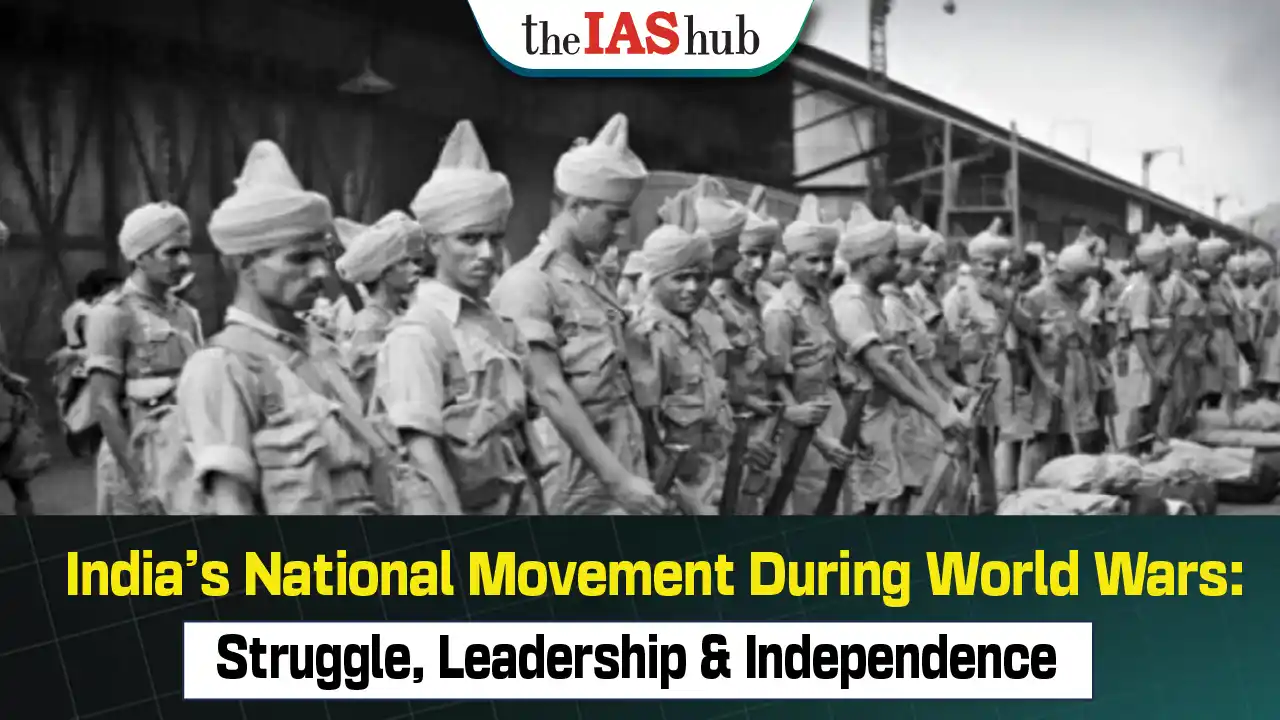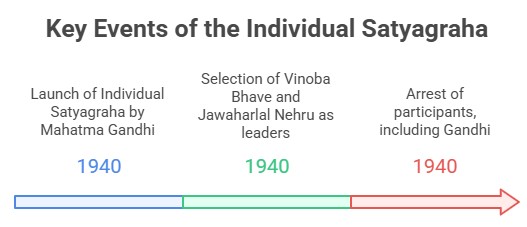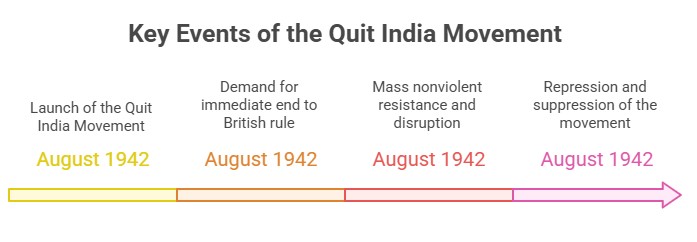During World War I and World War II, India's national movement experienced significant developments and played a crucial role in the country's struggle for independence from British colonial rule.
India’s National Movement during World War I and II
|
Parameters
|
World War I
|
World War II
|
|
Objective
|
To secure political concessions from the British in exchange for their support in the war effort.
|
The primary objective of the Indian national movement shifted towards demanding complete independence from British rule.
|
|
Role of leaders
|
The moderates, led by leaders like Bal Gangadhar Tilak and Gopal Krishna Gokhale, supported the British war effort and sought constitutional reforms and self-government.
|
Leaders such as Subhash Chandra Bose, disillusioned with nonviolent means, sought international support and formed INA to fight alongside the Axis powers against the British.
|
|
Popular movements
|
The Home Rule Movement, initiated by Annie Besant and Bal Gangadhar Tilak, demanded self-rule for India and gained significant support across the country.
|
The Quit India Movement, led by Mahatma Gandhi in 1942, called for the immediate withdrawal of the British from India and witnessed mass civil disobedience and protests.
|
|
Impact
|
The Indian nationalist movement gained momentum during this period, and the demand for self-rule became more prominent.
The efforts of Indian leaders and the sacrifices made by Indian soldiers during the war created a sense of unity and nationalism.
|
The war created economic hardships and political instability in India, leading to a surge in popular discontent and anti-colonial sentiments.
The end of World War II and the weakening of the British Empire internationally brought India closer to independence.
|
Overall, both periods marked significant milestones in India's struggle for freedom, laying the foundation for the country's eventual independence.
India’s National Movement and the August Offer
- It was a proposal made by the British government in August 1940 during World War II.
- It aimed to gain the support of Indian political parties and leaders in the war effort against the Axis powers.
- Promised the expansion of the Executive Council of Viceroy, with inclusion of more Indians, and the formation of a constituent assembly after the war to frame a new constitution.
- However, the offer fell short of the Indian nationalist demands for immediate and complete independence and was rejected.
Individual Satyagraha
- Individual Satyagraha was launched by Mahatma Gandhi in 1940 as a non-violent protest against British policies, specifically to voice dissent against India's forced involvement in World War II.
- Unlike mass movements, this campaign focused on individual acts of civil disobedience. Notable individuals like Vinoba Bhave and Jawaharlal Nehru were chosen by Gandhi to lead the protest.
- Participants spoke out against the war and criticized British decisions without calling for mass protests or strikes.
- The British government responded by arresting the participants, including Gandhi. e. Significance: This movement kept the momentum of the freedom struggle alive and emphasized the moral high ground of non-violence.
Growth of Communalism and India’s National Movement
- The period saw an increased polarization among religious communities, primarily Hindus and Muslims.
- In 1940, the Muslim League passed the Lahore Resolution, demanding a separate nation for Muslims, later known as Pakistan.
- These elections heightened communal tensions as the Muslim League and the Indian National Congress emerged as representatives of the Muslim and Hindu communities, respectively
- In 1946, the Muslim League called for Direct Action Day which resulted in widespread communal violence.
- The British colonial administration is often accused of employing a divide-and-rule policy that fueled communal tensions.
Peasant Movements
- Peasants faced economic hardships due to oppressive agricultural policies, taxation, and the impact of World War II.
- Tebhaga Movement: In 1946, this movement took place in Bengal, where sharecroppers demanded a reduction in the share of crops given to landlords.
- Telangana Rebellion: This was a peasant revolt in the Telangana region (now in Andhra Pradesh and Telangana) against the feudal lords and the Nizam between 1946 and 1951.
- Peasant movements found support from the Indian National Congress and Communist parties.
- These movements played a significant role in mobilizing the masses and weakening the British hold over rural India.
State People’s Struggle
- India had numerous princely states that were indirectly ruled by the British. The populace in these states also aspired to democratic governance and freedom
- People in the princely states campaigned for the integration of their states into the Indian Union.
- All India States People’s Conference (AISPC): This organization played a significant role in mobilizing people in the princely states for democratic rights and unification with India.
- Hyderabad, Junagadh, and Travancore: These were some of the princely states where people struggled against their rulers for integration with India.
Cripps Mission
- The Cripps Mission was a delegation sent to India in March 1942 by the British government, led by Sir Stafford Cripps.
- The mission aimed to seek Indian support for the British war effort in exchange for a promise of Dominion status and the right to determine India's future constitution.
- The proposals included the formation of an interim government with full Indian participation and the granting of the right to secede from the British Commonwealth.
However, the Cripps Mission failed to reach an agreement with Indian leaders, primarily due to disagreements over the issue of the Muslim League's demand for a separate homeland.
Quit India Movement
- The Quit India Movement was a significant civil disobedience movement launched by the Indian National Congress in August 1942.
- Led by Mahatma Gandhi, the movement demanded an immediate end to British rule in India.
- The movement aimed to create mass nonviolent resistance and disrupt British administration through strikes, protests, and non-cooperation.
- Although the movement faced repression and was eventually suppressed, it marked a turning point in the Indian independence struggle and further weakened the British hold on India
Wavell Plan
- The Wavell Plan, in 1945, aimed to resolve the political deadlock in India and facilitate the transfer of power.
- The plan called for the formation of an executive council with a majority of Indian members and the inclusion of representatives from the Muslim League.
- However, Congress rejected the plan, as it did not guarantee full independence and failed to address the issue of separate electorates for religious communities.
- The plan also faced opposition from the Muslim League, as it did not fulfil their demand for a separate homeland.
The failure of the Wavell Plan highlighted the deep divisions between Congress and the Muslim League and the challenges of achieving a united political solution.
INA, Subhas Chandra Bose, and India’s National Movement
Azad Hind Fauj or the India National Army was first established by Mohan Singh in 1942. It was revived by Netaji Subhas Chandra Bose on October 21, 1943, during the Second World War to secure India’s complete independence from British Raj.
Impact of INA
The INA had failed to achieve its goal, but it made a significant impact on the freedom struggle:
- It became clear to the British that, they could no longer depend on the loyalty of Indian Soldiers and treat them as mercenaries.
- The Red Fort Trials in which several captured INA soldiers were put on trial by the British at the Red Fort in Delhi, which further fueled nationalist sentiments.
- The INA's struggles showed that armed struggle against the British was not affected by communal division, as Hindus, Muslims, and Sikhs fought as Indians.
- The actions of Rani Jhansi Brigade, an exclusive women force, demonstrated the capabilities of Indian Women waging armed struggle against the British.
- The INA had also demonstrated the enthusiasm and concern of overseas Indians for the freedom of their motherland.
Subhash Chandra Bose's Contribution
- Dynamic Leadership: Bose's charismatic and dynamic leadership played a crucial role in rallying support for the INA and inspiring nationalist sentiments.
- Formation of Forward Bloc: Bose formed the Forward Bloc, a political organisation that aimed to unite all anti-colonial forces.
- Ideology of Socialism: Bose advocated for a socialist-oriented economic system that emphasised self-reliance and social justice.
- International Connections: Bose established connections with various leaders and organizations worldwide to gain support for India's freedom struggle.
- Controversial Escapes: Bose's escape from British custody and subsequent travels to Germany and Japan raised controversy but also showcased his determination to seek international support for India's independence.
- Vision for a Free India: Bose's vision for a free India emphasised social equality, economic development, and an inclusive society.
- Enduring Legacy: He is often remembered as a symbol of courage, resilience, and unwavering dedication to India's independence.
Hence, INA's military campaigns and Bose's dynamic leadership inspired nationalist sentiments and challenged British rule which continue to be remembered as an integral part of India's freedom movement.
Cabinet Mission Plan
The Cabinet Mission was a delegation sent by the British government to India in 1946 to propose a plan for India's independence and constitutional arrangements.
Objective: The mission aimed to find a solution to the growing political tensions between the Indian National Congress and the Muslim League, representing Hindu and Muslim interests.
Proposals:
- Union of India: The plan proposed the creation of a united India with a federal structure, comprising both British India and the princely states.
- Grouping of Provinces: The provinces were to be grouped into three sections based on religious majorities, providing a measure of autonomy to Muslim-majority provinces.
- Interim Government: The plan recommended the formation of an interim government with representatives from all major political parties until a permanent constitution could be adopted.
- Constituent Assembly: A Constituent Assembly was to be formed to draft a new constitution for independent India.
Acceptance and Rejection:
- The Indian National Congress initially accepted the plan, while the Muslim League rejected it, as they insisted on a separate Pakistan for Muslims.
Post-WWII Nationalist Upsurge in India’s National Movement
- The end of World War II marked a significant shift in India, with a rise in popular initiatives across the country.
- There were various anti-imperialist movements such as the country-wide strike wave, the Tebhaga Movement, the Warlis Revolt, the Punjab kisan morchas, the Travancore people's struggle, and the Telengana Movement?.
- Despite the repression of the Quit India Movement in 1942 and the hardships of the war, the Indian populace remained resilient?.
- The election campaign saw large crowds and frantic excitement. In the provincial elections, the Congress won over 90% of the general seats, and the Muslim League did the same in Muslim constituencies. The campaign sought to mobilize Indians against the British, not just voters for the elections.
- The repression in 1942 and the Indian National Army trials were significant issues during the election campaign.
Independence with Partition
Independence of India and Pakistan through Partition
- Clement Attlee's Labour Government developed legislation based on the Mountbatten Plan or the 3rd June Plan.
- British Prime Minister announced on February 20, 1947, that British India would attain self-governance by June 1948.
- The Mountbatten Plan was agreed upon by Indian National Congress and Muslim League leaders and implemented on June 3, 1947.
- The Independence Act, embodying the Mountbatten Plan, declared India and Pakistan independent from August 15, 1947.
- The Boundary Commission delineated new borders, and British suzerainty over princely states ended.
- Princely states had to choose to join India, Pakistan, or stay independent; over 560 opted for India.
- Until the new dominions established their constitutions, Governor-Generals acted as heads of state with the ability to assent to laws through Constituent Assemblies.
- The Royal Assent to the Independence Act was granted on July 18, 1947, bringing it into effect.
The passage of the Indian Independence Act in 1947 marked a turning point in India's constitutional journey. This legislation heralded the dawn of a new era of liberty in India, even though it was met with discontent among many citizens. Regardless of its shortcomings, the Act undoubtedly culminated in the cessation of British dominance in India.














